As I delve into the rich tapestry of Native American culture, one element that stands out is the profound importance of the Douglas Fir tree. This majestic tree holds a significant place in the spiritual and practical traditions of various Native American tribes. From its traditional uses to its symbolism in indigenous traditions, the Douglas Fir is deeply intertwined with the cultural fabric of Native American communities.
Key Takeaways:
- The Douglas Fir is revered for its spiritual significance and cultural symbolism in Native American culture.
- Native tribes have traditionally used the Douglas Fir for its practical applications, such as tools and shelter.
- The Douglas Fir plays a vital role in Native American rituals and ceremonies.
- Its symbolism represents strength, resilience, and the interconnectedness of all living beings.
- Efforts are underway to conserve and preserve the cultural heritage associated with the Douglas Fir.
Traditional Uses of Douglas Fir in Native American Culture
Native tribes have long relied on the versatile Douglas Fir for a wide range of traditional practices. This majestic tree, deeply rooted in Native American culture, has been utilized for its practical, spiritual, and medicinal properties. Let’s explore some of the traditional uses of Douglas Fir that have shaped Native American culture throughout history.
- Douglas Fir Tools: The sturdy wood of the Douglas Fir has been invaluable in crafting various tools. Tribes used it to create spear and harpoon shafts, fishing hooks, and handles for everyday implements.
- Douglas Fir Shelter: The branches of the Douglas Fir played an integral role in the construction of Native American dwellings. Used to cover the floors of lodges and sweat lodges, the branches provided insulation and protection from the elements.
- Douglas Fir Medicine: Native American medicine often incorporated the bark and resin of the Douglas Fir. The bark was used for its antimicrobial properties, while the resin had potential applications in treating wounds and respiratory ailments.
The cultural significance of the Douglas Fir extends far beyond its practical uses. It holds a sacred place in Native American culture, symbolizing resilience, strength, and a deep connection to the natural world. The next section will delve into the spiritual significance of the Douglas Fir in Native American traditions.

| Symbolic Meanings of the Douglas Fir in Native American Culture | Description |
|---|---|
| Protection and Shelter | The Douglas Fir is believed to offer spiritual protection and serve as a shelter during challenging times. |
| Resilience and Survival | The tree’s cones symbolize resilience and the ability to endure and thrive in difficult conditions. |
| Guardian and Strength | The Douglas Fir is viewed as a guardian and a source of strength in indigenous traditions. |
| Interconnectedness | The tree represents the interconnectedness of all living beings and the importance of maintaining harmony with nature. |
Douglas Fir in Native American Rituals
The Douglas Fir holds a sacred place in Native American culture and is frequently incorporated into rituals and ceremonial practices. Its branches, bark, and resin play significant roles in various spiritual and cultural ceremonies, symbolizing purification, protection, and a connection to the spiritual realm.
“The Douglas Fir is a sacred tree, used in our rituals to cleanse and purify ourselves before engaging in important ceremonies. Its branches are often burned as incense, filling the air with a fragrant smoke that carries our prayers to the heavens.”
In Native American culture, rituals hold great importance as a means of connecting with the divine and reaffirming cultural identity. The Douglas Fir’s presence in these rituals strengthens the bond between the natural world and indigenous traditions, acknowledging the tree’s status as a sacred symbol.
- During cleansing rituals, Native Americans use bundles of Douglas Fir branches, known as smudge sticks, to create smoke that is believed to purify the mind, body, and spirit.
- The bark of the Douglas Fir tree is used to create ceremonial drums, which hold deep spiritual significance in various Native American tribes.
- Resin from the Douglas Fir is often used as an offering in ceremonies, symbolizing a spiritual connection and gratitude for the tree’s gifts.

The Douglas Fir’s participation in Native American rituals showcases the profound respect and reverence for nature present in indigenous cultures. Through these sacred practices, Native Americans embody their ancestral traditions while honoring the spiritual and cultural significance of this remarkable tree.
Cultural Significance of Douglas Fir in Native American Culture
In Native American culture, the Douglas Fir holds immense cultural significance. It is deeply intertwined with traditional beliefs and indigenous customs, symbolizing the rich tapestry of Native American heritage. The tree’s presence in ceremonies, artwork, and storytelling reflects its importance as a powerful symbol of strength, wisdom, and harmony with nature. Let’s explore the profound cultural significance of Douglas Fir in Native American traditions.
Spiritual Beliefs and Practices
The Douglas Fir is revered by Native American communities for its spiritual qualities. It is seen as a sacred connection to the natural world, representing the enduring strength and resilience of indigenous people. In spiritual rituals, the tree is often used as a symbol of protection, purification, and grounding. Its majestic presence serves as a gateway to spiritual realms and fosters a deep sense of spiritual connection among Native American practitioners.
Artistic Expression and Symbolism
The cultural significance of Douglas Fir is beautifully woven into the artistic traditions of Native American communities. The tree’s distinctive form and majestic presence inspire awe and reverence, making it a prominent subject in Native American artwork, carvings, and totem poles. Through intricate designs and skilled craftsmanship, these artistic expressions depict the spiritual essence of the tree and convey profound messages about the interconnectedness of all living beings.
| Art Form | Description |
|---|---|
| Carvings and Sculptures | Native American artisans skillfully carve Douglas Fir wood to create intricate sculptures that depict traditional stories, ancestral figures, and spiritual beings. These sculptures serve as tangible representations of cultural heritage and preserve the deep-rooted connection between Native American communities and the Douglas Fir. |
| Storytelling | Through oral traditions and storytelling, Native American elders pass down ancient tales that incorporate the symbolism and mythology of the Douglas Fir. These stories serve as lessons in wisdom, resilience, and the importance of living in harmony with nature. |
Community Gatherings and Rituals
Native American communities honor the cultural significance of the Douglas Fir through the practice of traditional ceremonies and gatherings. These gatherings provide a sacred space for connecting with nature, ancestral spirits, and one another. The Douglas Fir is often central to these rituals, serving as a focal point for prayers, offerings, and collective reflection.
“The Douglas Fir represents the strength and wisdom passed down by our ancestors. It is a reminder of our deep connection to the land and our responsibility to protect and preserve our cultural heritage.” – Chief White Cloud, Navajo Tribe
The Douglas Fir, through its roots, branches, and towering presence, embodies the cultural identity and spiritual beliefs of Native American communities. Its cultural significance remains profound, fostering a sense of belonging, reverence, and unity among Native Americans and honoring the wisdom of their ancestors.

Importance of Douglas Fir in Native American Lore
Douglas Fir holds a significant place in Native American culture, especially in terms of folklore, mythologies, and storytelling. Stories passed down through generations have placed the tree at the center, attributing special qualities to it and recognizing its profound role in Native American lore.
These tales serve as a means to preserve cultural heritage and wisdom, while also imparting important lessons about the interconnectedness of all living beings and the need for respect and harmony with nature.
“In the ancient stories of my people, the Douglas Fir is revered as a guardian of the forest, a wise and nurturing presence that watches over us. It is said that the tree holds the secrets of the universe, whispering its wisdom to those who take the time to listen.” – Tribal Elder
Native American tribes have long recognized the spiritual significance of the Douglas Fir and its ability to connect humanity with the natural world. The tree is often depicted as a symbol of protection, wisdom, and resilience, showcasing the deep reverence that indigenous communities have for this remarkable species.
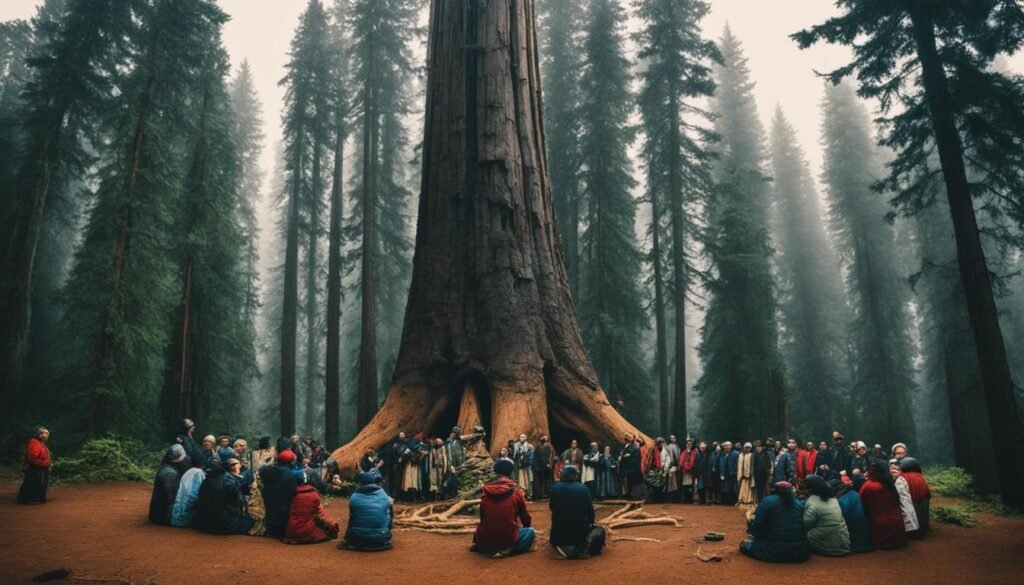
| Folklore and Mythologies | Key Aspects |
|---|---|
| Guardian of the Forest | Believed to protect the land and its inhabitants |
| Provider of Wisdom | Considered a source of ancient knowledge and guidance |
| Interconnectedness | Symbolic of the harmony between humans, nature, and the spiritual realm |
This reverence for the Douglas Fir in Native American lore highlights the deep spiritual connection indigenous communities have with the natural world. These stories not only entertain and inspire, but also transmit important cultural values and teachings across generations.
Preservation of Cultural Heritage
By recognizing and appreciating the importance of Douglas Fir in Native American lore, efforts are being made to preserve and protect these stories and their associated cultural heritage. As indigenous communities continue to share and pass down these tales, the wisdom and deep respect for nature they embody will be safeguarded for future generations.
Douglas Fir’s Significance in Native American Medicine
Native American communities have long recognized the healing properties of the Douglas Fir tree and have incorporated it into their traditional healing practices. The bark, resin, and pine needles of the Douglas Fir have been utilized in herbal remedies to address a range of ailments.
The medicinal applications of the Douglas Fir in Native American medicine are diverse. The bark, when prepared as decoctions or poultices, has been used to alleviate stomach aches and digestive issues. Its resin, known for its antibacterial properties, has been employed topically to soothe skin irritations and promote wound healing.
The pine needles of the Douglas Fir possess aromatic qualities and have been utilized in steam baths and infusions to treat respiratory conditions such as coughs, congestion, and colds. The tree’s natural compounds, including beta-pinene and limonene, are believed to contribute to its therapeutic effects.
The cultural significance of the Douglas Fir goes beyond its medicinal properties. Native Americans regard the tree as a powerful spirit ally, connecting them to the healing energies of the natural world. It is seen as a symbol of renewal and vitality, encompassing the interconnectedness of all living things.
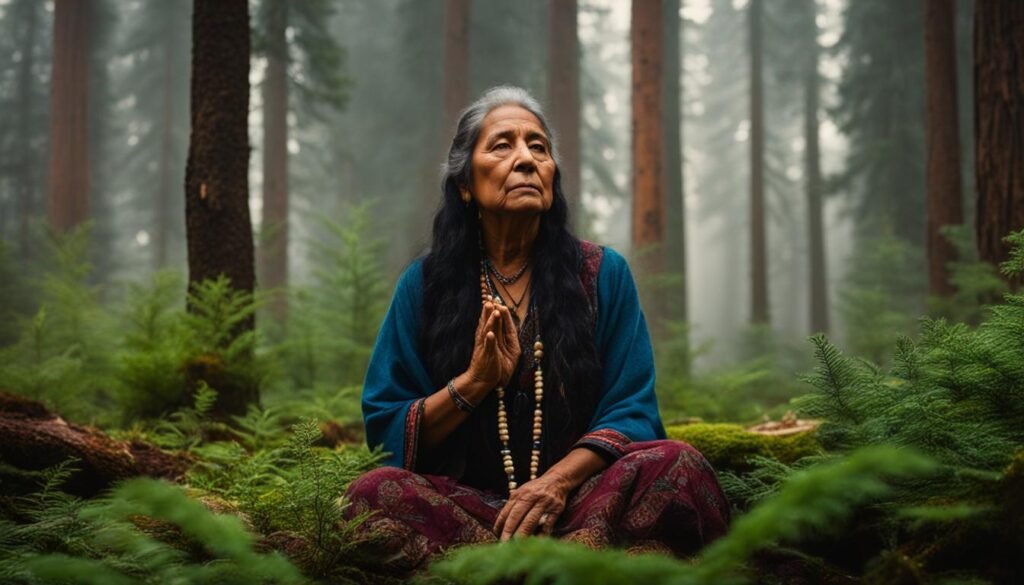
Traditional Herbal Remedies Utilizing Douglas Fir
Native American healing practices often involve the use of herbal remedies, and the Douglas Fir features prominently in these traditions. Here are a few examples of traditional remedies:
- Douglas Fir Bark Tea: Boiling the bark of the Douglas Fir tree to create a bitter-tasting tea that is believed to help with digestive issues and stomach discomfort.
- Douglas Fir Resin Salve: Extracting the sticky resin from the tree and combining it with other ingredients to create a salve that can be applied topically to wounds, cuts, and skin irritations.
- Douglas Fir Steam Bath: Steeping Douglas Fir pine needles in hot water and inhaling the aromatic steam to relieve respiratory congestion and promote a sense of well-being.
Native American healing practices often emphasize the holistic nature of health and the importance of maintaining balance and harmony within oneself and with the natural world. The use of Douglas Fir in herbal remedies not only addresses physical ailments but also connects individuals to the spiritual and cultural heritage of their communities.
Douglas Fir’s Symbolism in Indigenous Traditions
The Douglas Fir holds deep symbolic meaning in indigenous traditions. It represents strength, resilience, and the ability to weather adversity. Its towering presence and dense foliage serve as a reminder of the enduring spirit of Native American communities.
The tree’s symbolism extends beyond its physical attributes, symbolizing the interconnectedness of all living beings and the importance of maintaining harmony with nature.
“The Douglas Fir stands tall, surviving the harshest storms, just as our ancestors stood against all odds, preserving our traditions and heritage. It reminds us that we, too, have the strength to overcome any challenges that come our way.”
In Native American culture, the spiritual meaning of the Douglas Fir goes beyond its physical presence. It represents the sacred bond between humanity and the natural world, reminding us of our responsibility to protect and honor the earth.
The Symbolic Significance of the Douglas Fir:
- Strength and resilience
- Connection between all living beings
- Endurance and longevity
- Harmony with nature
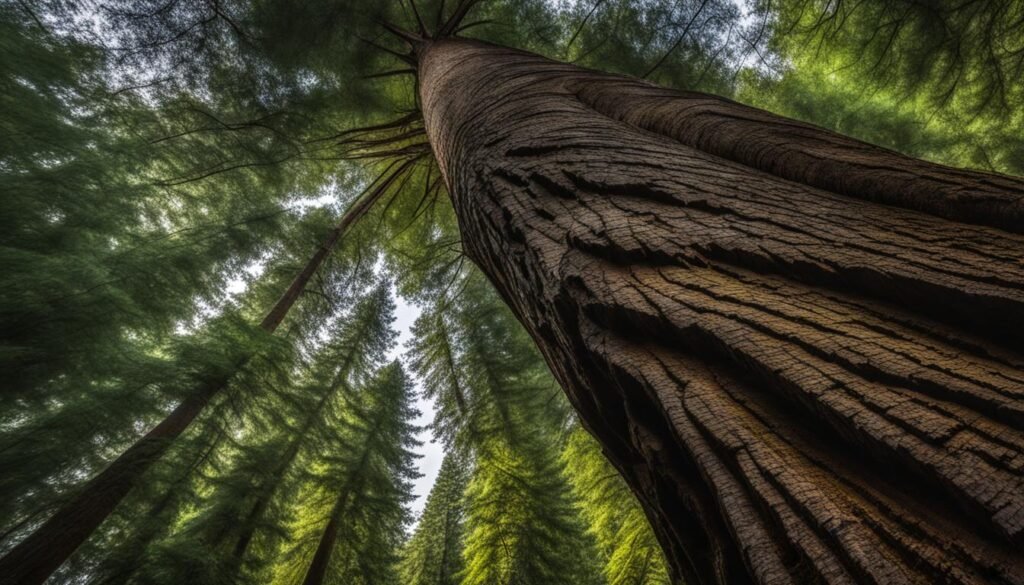
| Symbolic Meaning | Representation |
|---|---|
| Strength | The Douglas Fir represents the strength of Native American communities and their ability to overcome adversity. |
| Resilience | Just as the Douglas Fir weathers storms, it symbolizes the resilience and perseverance of indigenous cultures. |
| Interconnectedness | The tree’s branches and roots symbolize the interconnectedness of all living beings and the unity of Native American communities. |
| Harmony with nature | The Douglas Fir serves as a reminder to maintain a harmonious relationship with the natural world and respect the earth’s resources. |
Relevance of Douglas Fir in Modern Native American Practices
Even in modern times, the Douglas Fir continues to hold great relevance and significance in Native American practices. This majestic tree serves as a powerful symbol of cultural preservation, reminding communities of their roots and ancestral wisdom.
For many Native Americans, the Douglas Fir is not just a physical presence in their surroundings, but also a spiritual connection to their cultural identity. The tree is deeply ingrained in their traditions and beliefs, representing a sacred bond with the natural world and ancient wisdom.
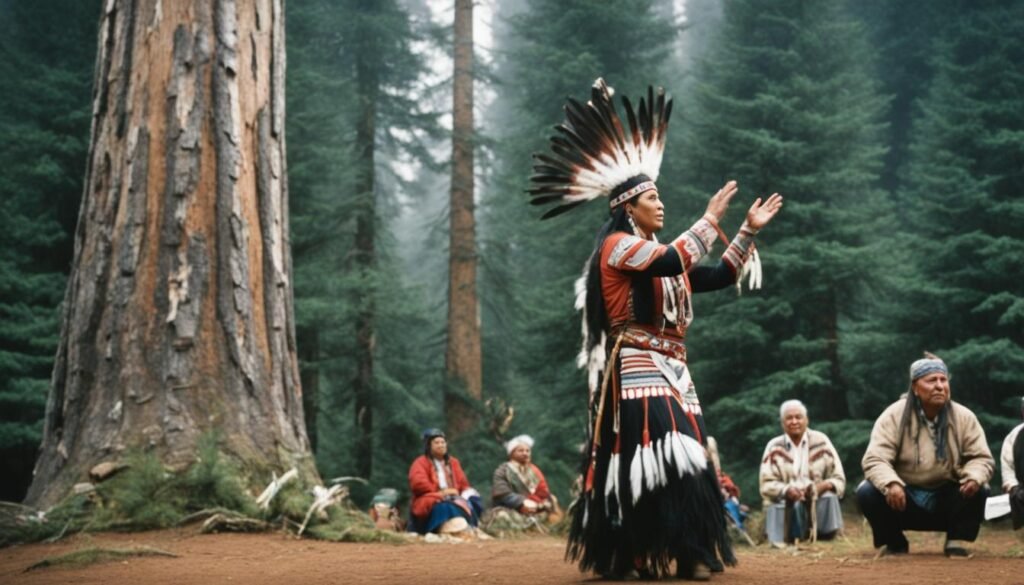
These days, Douglas Fir is still incorporated into contemporary rituals and ceremonies, demonstrating its enduring importance in Native American culture. It serves as a tangible link to the past, embodying ancestral traditions and values that are passed down through generations.
“The Douglas Fir is like a bridge that connects us to our roots. It reminds us of who we are and where we come from, and it helps us preserve our cultural heritage.” – Native American Elder
Native Americans perceive the Douglas Fir as more than just a tree; it is a source of inspiration, strength, and spiritual connection. Its evergreen nature symbolizes resilience and renewal, providing a constant reminder of the enduring spirit of Native American communities.
In the hustle and bustle of the modern world, the Douglas Fir serves as a reminder to Native Americans to stay true to their values, to honor their cultural heritage, and to maintain harmony with the natural environment. It is an embodiment of the deep-rooted spiritual connection that Native Americans have with nature and the world around them.
In the next section, we will explore the economic and practical uses of Douglas Fir, showcasing its versatility beyond its cultural and spiritual significance.
Economic and Practical Uses of Douglas Fir
Apart from its cultural and spiritual significance, the Douglas Fir also has important economic and practical applications. Its strength, hardness, and durability make it a highly sought-after softwood timber in the forestry industry. The versatile timber of the Douglas Fir is widely used in various applications such as joinery, veneer, flooring, and construction.
The timber industry benefits immensely from the abundance of Douglas Fir trees, which provide a sustainable and renewable source of timber resources. Throughout the years, forestry practices have been developed to ensure the responsible management and harvesting of Douglas Fir trees, minimizing the impact on the environment while meeting the demands of the construction industry.
In addition to its use as a construction material, the Douglas Fir is also commonly grown as a Christmas tree due to its symmetrical shape, dense foliage, and pleasant fragrance. Its ornamental appeal makes it a popular choice for large parks and gardens, adding beauty and a touch of nature to festive celebrations.

The Benefits of Using Douglas Fir in Construction
The use of Douglas Fir timber in construction offers several advantages. The exemplary strength and durability of the wood make it ideal for structural applications, ensuring the longevity and stability of buildings and other structures. Additionally, the dimensional stability of Douglas Fir minimizes warping and shrinking, providing reliable and consistent construction materials.
Douglas Fir is favored in construction for its natural resistance to decay and insects. This reduces the need for chemical treatments, making it an environmentally-friendly choice in building projects. Furthermore, the attractive appearance of the wood, with its warm reddish-brown tones and distinctive grain patterns, adds a touch of natural beauty to interiors and exteriors.
“The use of Douglas Fir in construction combines strength, durability, and natural beauty, making it a versatile and sustainable choice for builders and architects.” – Construction Expert
The Significance of Sustainable Forestry Practices
The timber industry acknowledges the importance of sustainable forestry practices in preserving and replenishing the Douglas Fir resources. By implementing responsible harvesting techniques, such as clear-cutting and selective logging, the industry ensures the long-term viability of the Douglas Fir population.
- Clear-cutting promotes the regeneration of young Douglas Fir saplings, allowing for the growth of new trees and the continuation of the species’ lifecycle.
- Selective logging targets specific mature trees for harvesting, maintaining the overall health and diversity of the forest ecosystem.
- Reforestation initiatives are crucial in replanting Douglas Fir trees, preserving the natural balance and maintaining the availability of timber resources for future generations.
Preserving the ecological integrity of Douglas Fir forests goes hand in hand with sustaining the cultural and spiritual significance of the tree in Native American culture. By fostering a harmonious relationship between forestry practices and cultural preservation, the industry acknowledges the importance of maintaining the sacred connection between nature and Native American traditions.
| Practical Applications of Douglas Fir | Economic Uses |
|---|---|
| Joinery | Construction |
| Veneer | Flooring |
| Furniture | Christmas trees |
Douglas Fir’s Role in Traditional Crafts and Artistry
The versatility of Douglas Fir extends beyond its cultural and spiritual significance in Native American culture. Native American artisans have long recognized the exceptional qualities of this tree and have utilized its wood in crafting intricate sculptures, totem poles, and other forms of artistic expression. The unique characteristics of Douglas Fir, including its distinct grain pattern and exceptional durability, make it a favored material for creating lasting works of art that embody the rich heritage and traditional artistry of Native American culture.
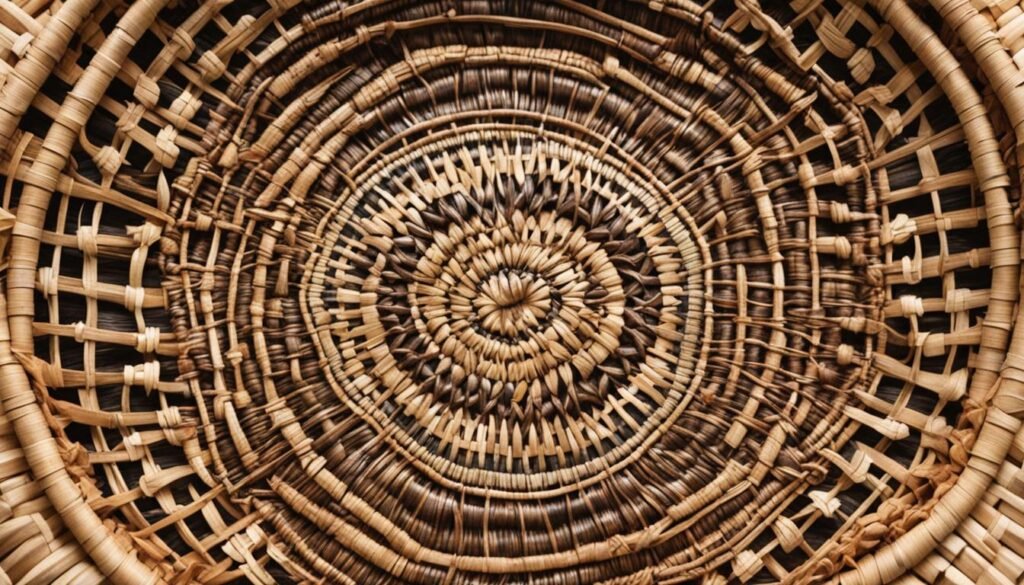
Whether it’s delicate carvings or imposing totem poles, Douglas Fir serves as a canvas for artists to showcase their skill and tell stories through their craftsmanship. The wood’s natural beauty and strength give life to intricate details and allow for the creation of larger-than-life sculptures that captivate and inspire.
Native American artisans have always understood the intimate connection between nature and art. The use of Douglas Fir in traditional crafts is a testament to their respect for natural resources and their ability to transform humble materials into masterful works of art.
The significance of Douglas Fir in traditional crafts and artistry goes beyond aesthetic appeal. It holds deep cultural meaning for Native American communities, representing a connection to their ancestral traditions and the natural world around them. By embracing the unique qualities of Douglas Fir, Native American artisans continue to preserve and pass on their traditional artistry for future generations to appreciate and admire.
Traditional Crafts and Artistic Expressions Utilizing Douglas Fir
| Art Form | Description |
|---|---|
| Sculptures | Artists carve intricate sculptures depicting deities, animals, and symbolic figures, showcasing their mastery of form and detail. |
| Totem Poles | Totem poles, towering wooden structures adorned with intricate carvings, serve as cultural landmarks, conveying stories and values. |
| Masks | Masks carved from Douglas Fir allow artists to embody spiritual or mythological beings, bringing cultural narratives to life. |
| Canoe Construction | Native artisans skillfully shape and carve canoes using Douglas Fir, combining function and artistry in these traditional watercraft. |
| Traditional Instruments | From drums to flutes, the wood of the Douglas Fir is shaped into traditional musical instruments, creating melodies that resonate with cultural significance. |
The artistry and creativity exhibited by Native American artisans using Douglas Fir demonstrate the enduring significance of this tree and its noble place within Native American culture. Through their crafts, these artists impart stories and preserve traditions, paying homage to the profound connection between nature, culture, and art.
Significance of Douglas Fir as a Food Source
Native American communities have long recognized the Douglas Fir as a valuable food source, reflecting their deep connection to the natural environment and their traditional food practices. The tree’s cones contain seeds that serve as a nutritious food for various small mammals found in these communities.
Small mammals such as chipmunks, mice, and squirrels rely on the seeds of the Douglas Fir as a vital part of their diet. These animals play a significant role in the ecosystem, contributing to seed dispersal and promoting the regeneration of the Douglas Fir population.
Furthermore, bears have been observed utilizing the tree’s sap as a source of nutrition. They have been known to lick the sticky sap, which provides them with essential calories and nutrients.
This utilization of the Douglas Fir as a food source exemplifies the sustainable relationship that Native American communities have nurtured with their surroundings for centuries. By understanding and respecting the natural resources around them, these communities have been able to meet their nutritional needs while preserving the delicate balance of the ecosystem.
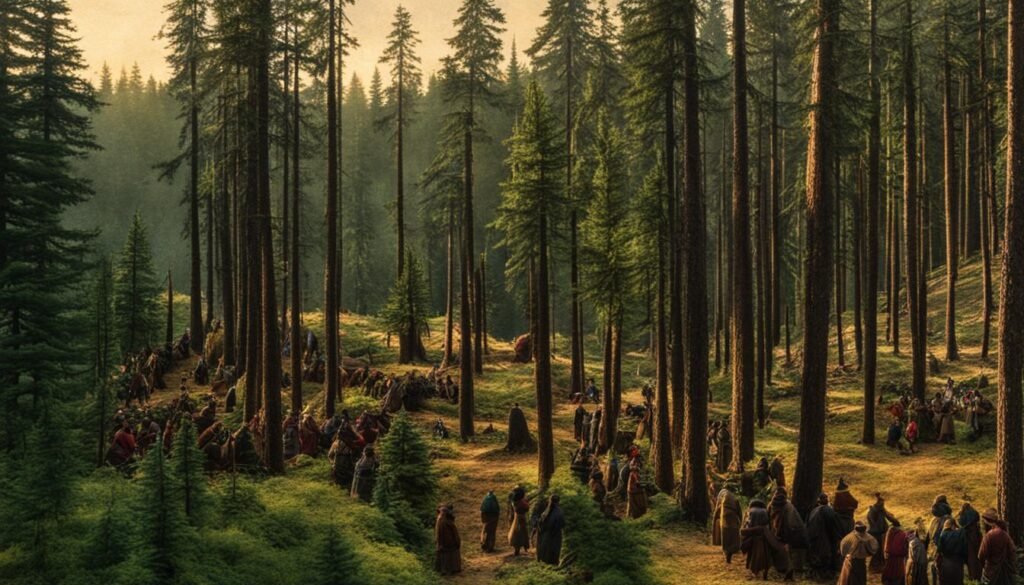
| Small Mammals | Douglas Fir Seeds |
|---|---|
| Chipmunks | Eat the seeds as a primary food source and boost seed dispersal through caching behavior. |
| Mice | Consume the seeds, meeting their nutritional requirements and contributing to seed dispersal. |
| Squirrels | Feed on the seeds, aiding in seed dispersal and promoting forest regeneration. |
Table: Small Mammals and their Relationship with Douglas Fir Seeds
Douglas Fir and Native American Sustainability Practices
Native American communities have always prioritized environmental conservation and sustainability. Recognizing the cultural and ecological significance of the Douglas Fir, tribes have implemented conservation efforts to ensure its long-term survival and maintain its widespread presence. Through sustainable practices in forestry and resource management, tribes strike a delicate balance between utilizing the tree’s resources and preserving its natural habitat.
The Douglas Fir, with its towering presence and vital role in Native American culture, serves as a powerful symbol for environmental conservation. By protecting this iconic tree, native communities uphold their commitment to sustainable practices and show reverence for the interconnectedness of all living beings.
The Importance of Native American Sustainability Practices
Native American sustainability practices encompass a holistic approach to environmental management, influenced by centuries of ancestral knowledge and spiritual beliefs. These practices emphasize the preservation of ecosystems, the responsible use of natural resources, and the promotion of a harmonious relationship with nature.
“We are stewards of the earth, entrusted with the task of preserving its beauty and resources for future generations.” – Native American proverb
Native American communities view nature as a provider and caretaker, acknowledging their responsibility to maintain the delicate balance between human needs and the well-being of the environment. The preservation of the Douglas Fir goes hand in hand with this commitment to environmental conservation.
Sustainable Practices in Forestry and Resource Management
Native American tribes integrate sustainable forestry and resource management practices to ensure the preservation of the Douglas Fir and its ecosystem. These practices include:
- Implementing responsible logging techniques that minimize the impact on the environment.
- Engaging in reforestation efforts to replenish the Douglas Fir population.
- Supporting scientific research to better understand the tree’s needs and ecological requirements.
- Collaborating with governmental agencies and conservation organizations to develop comprehensive conservation plans.
| Sustainable Practices in Douglas Fir Conservation | Benefits |
|---|---|
| Selective Harvesting | Ensures the regeneration and long-term viability of Douglas Fir forests. |
| Forest Stewardship | Promotes biodiversity and the preservation of wildlife habitat within Douglas Fir ecosystems. |
| Community Outreach | Engages and educates the local community about the importance of sustaining the Douglas Fir population. |
| Ecosystem Restoration | Rehabilitates degraded Douglas Fir habitats to support the growth and health of the tree species. |
Through these efforts, Native American tribes ensure that future generations can continue to benefit from the cultural, environmental, and economic value of the Douglas Fir.

Cultural Appreciation and Conservation of Douglas Fir
Recognizing the cultural appreciation of Douglas Fir, efforts are underway to conserve and preserve this significant tree. Collaboration between Native American tribes, conservation organizations, and governmental agencies aims to protect the tree and its cultural meaning. This involves sustainable forest management, reforestation initiatives, and raising awareness about the importance of Douglas Fir in Native American culture.
The Significance of Cultural Appreciation
Cultural appreciation of the Douglas Fir goes beyond its physical attributes. Native American culture holds a deep reverence for this majestic tree, treasuring its spiritual and traditional significance. The Douglas Fir embodies the interconnectedness between nature and indigenous communities, serving as a symbol of resilience, wisdom, and harmony with the natural world.
Collaborative Conservation Efforts
To ensure the preservation of both the Douglas Fir and Native American cultural heritage, collaborative efforts are crucial. Native American tribes, conservation organizations, and governmental agencies work together to develop sustainable forest management practices. By implementing responsible harvesting techniques and promoting reforestation initiatives, they strive to maintain the long-term viability of the Douglas Fir ecosystem.
Preserving Native American Traditions
The conservation of the Douglas Fir also plays a vital role in preserving Native American traditions. By protecting this culturally significant tree, communities can continue to pass down traditional knowledge and practices to future generations. The preservation of the Douglas Fir helps Native American tribes maintain their cultural identity and strengthens the connection between ancestral wisdom, spirituality, and the natural environment.
Raising Awareness
Raising awareness about the importance of the Douglas Fir in Native American culture is essential for its long-term conservation. Through educational programs, public outreach, and storytelling, the significance of the tree and its role in indigenous traditions can be shared with a wider audience. By fostering appreciation and understanding, we can foster a deeper respect for Native American culture and the natural resources that sustain it.
| Conservation Activities | Benefits |
|---|---|
| Sustainable forest management | Preserves the Douglas Fir ecosystem and ensures a renewable resource for future generations. |
| Reforestation initiatives | Helps restore and expand Douglas Fir habitats, aiding in the conservation of native plant and animal species. |
| Educational programs | Raises awareness about the cultural significance of the Douglas Fir and fosters a deeper appreciation for Native American traditions. |
| Public outreach | Engages the wider community in conservation efforts, promoting the preservation of both cultural heritage and natural resources. |
“The Douglas Fir is not only a tree but a cultural treasure, embodying the wisdom and traditions of Native American communities. By working together to conserve this remarkable species, we honor and preserve the rich heritage it represents.”

Conclusion
Throughout Native American culture, the Douglas Fir holds a central and revered place. Its spiritual significance, traditional uses, and cultural relevance reflect the deep connection between Native American communities and the natural world. The tree’s enduring presence in rituals, folklore, and artistic expression signifies its sacred connection and importance.
To ensure the preservation of Native American traditions and their sacred connection to nature, it is crucial to appreciate and protect the cultural heritage associated with the Douglas Fir. Conservation efforts, sustainable practices, and education initiatives play a vital role in raising awareness about the spiritual and ecological significance of this tree.
By highlighting the spiritual symbolism, traditional uses, and cultural preservation of the Douglas Fir in Native American culture, we honor the deep-rooted traditions and ancestral wisdom intertwined with this magnificent tree. Understanding and respecting the Douglas Fir’s significance contribute to the richness and preservation of Native American heritage for generations to come.
FAQ
What is the role of Douglas Fir in Native American culture?
Douglas Fir has played a significant role in Native American culture, with various tribes utilizing this tree for its spiritual and practical purposes.
What are some traditional uses of Douglas Fir in Native American culture?
Native tribes have used Douglas Fir wood for tools such as spear and harpoon shafts, fishing hooks, and handles. Its branches were used to cover lodge floors and for purification in certain rituals. Douglas Fir bark and resin were also used in Native American medicine.
What is the spiritual significance of Douglas Fir in Native American culture?
The Douglas Fir is regarded for its spiritual significance and is believed to offer protection and shelter. It symbolizes resilience and survival, with the image of a mouse seeking refuge beneath its cones. The tree is viewed as a guardian and source of strength.
How is Douglas Fir incorporated into Native American rituals?
Douglas Fir branches, bark, and resin are used in rituals and offerings, symbolizing purification, protection, and connection to the spiritual realm. Its presence in ceremonies strengthens the bond between the natural world and Native American traditions.
What is the cultural significance of Douglas Fir in Native American culture?
Douglas Fir is deeply intertwined with traditional beliefs and indigenous customs. Its presence in ceremonies, artwork, and storytelling reflects its importance as a symbol of strength, wisdom, and harmony with nature. It represents the deep connection between Native American communities and the natural world.
What is the importance of Douglas Fir in Native American folklore?
Douglas Fir features prominently in Native American folklore and mythologies, often attributed special qualities such as its role as a guardian or provider of wisdom. These tales serve to preserve cultural heritage and impart important lessons about respect for nature and the interconnectedness of all living beings.
How is Douglas Fir used in Native American medicine?
Native Americans have used various parts of the Douglas Fir for medicinal purposes. The bark, resin, and pine needles were employed in traditional healing practices to treat ailments such as stomach aches, headaches, rheumatism, and the common cold. The tree’s natural properties were believed to possess therapeutic qualities.
What is the symbolism of Douglas Fir in indigenous traditions?
Douglas Fir symbolizes strength, resilience, and the ability to weather adversity. Its towering presence and dense foliage serve as a reminder of the enduring spirit of Native American communities. The tree’s symbolism extends beyond its physical attributes, reflecting the interconnectedness of all living beings and the importance of maintaining harmony with nature.
How does Douglas Fir remain relevant in modern Native American practices?
Douglas Fir is revered as a symbol of cultural preservation, reminding communities of their roots and ancestral wisdom. Many Native Americans maintain a spiritual connection with the tree, incorporating it into contemporary rituals and ceremonies, recognizing its enduring cultural importance.
What are the economic and practical uses of Douglas Fir?
Douglas Fir is extensively used in forestry for softwood timber known for its strength and durability. The timber is utilized in joinery, veneer, flooring, and construction. Additionally, it is commonly grown as a Christmas tree and valued for its ornamental appeal in large parks and gardens.
How is Douglas Fir used in traditional crafts and artistry?
Native American artisans have utilized the wood of Douglas Fir in crafting intricate sculptures, totem poles, and other forms of artistic expression. The unique characteristics of the wood, including its grain and durability, make it a favored material for creating lasting works of art reflecting Native American heritage.
Is Douglas Fir used as a food source in Native American culture?
Native American groups have recognized the Douglas Fir as a valuable food source. The seeds found within the tree’s cones have been consumed by various small mammals, including chipmunks, mice, and squirrels. Additionally, the tree’s sap has been used by bears as a source of nutrition.
How is Douglas Fir connected to Native American sustainability practices?
Native American communities prioritize environmental conservation and sustainability. Conservation efforts are focused on practices such as sustainable forestry and resource management to maintain the balance between utilizing the tree’s resources and ensuring its long-term survival.
How is Douglas Fir conserved and preserved in Native American culture?
Efforts are underway to conserve and preserve the Douglas Fir tree, recognized for its cultural significance. Collaboration between Native American tribes, conservation organizations, and governmental agencies involves sustainable forest management, reforestation initiatives, and raising awareness about the importance of Douglas Fir in Native American culture.
What is the role of education and cultural outreach programs in preserving Douglas Fir’s cultural significance?
Educational initiatives and cultural outreach programs play a vital role in promoting awareness and understanding of Douglas Fir’s importance in Native American culture. These programs aim to educate individuals about the spiritual, traditional, and ecological significance of the tree, contributing to the preservation and celebration of Native American traditions.
How does the Douglas Fir contribute to the preservation of Native American traditions?
Through its spiritual significance, traditional uses, symbolism, and cultural relevance, the Douglas Fir holds a central place in Native American culture. Efforts to appreciate and conserve the cultural heritage associated with the Douglas Fir are essential for ensuring the preservation of Native American traditions and their sacred connection to nature.




